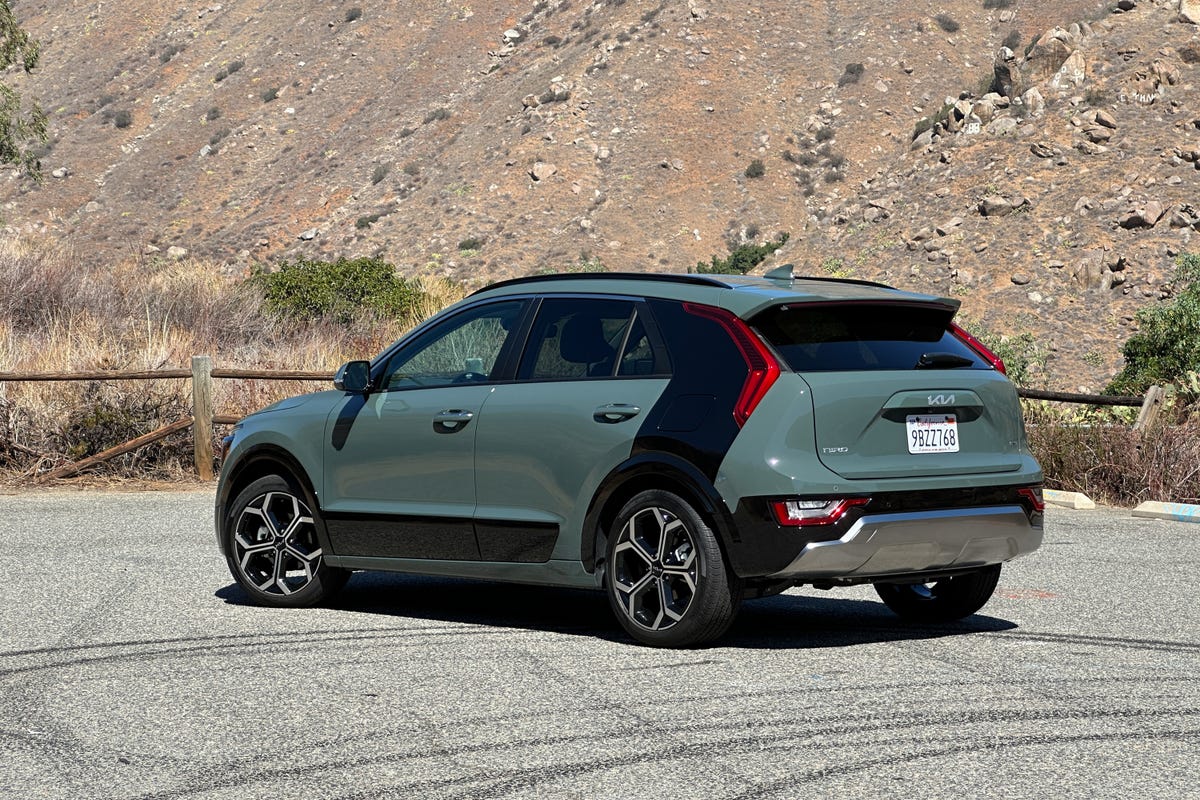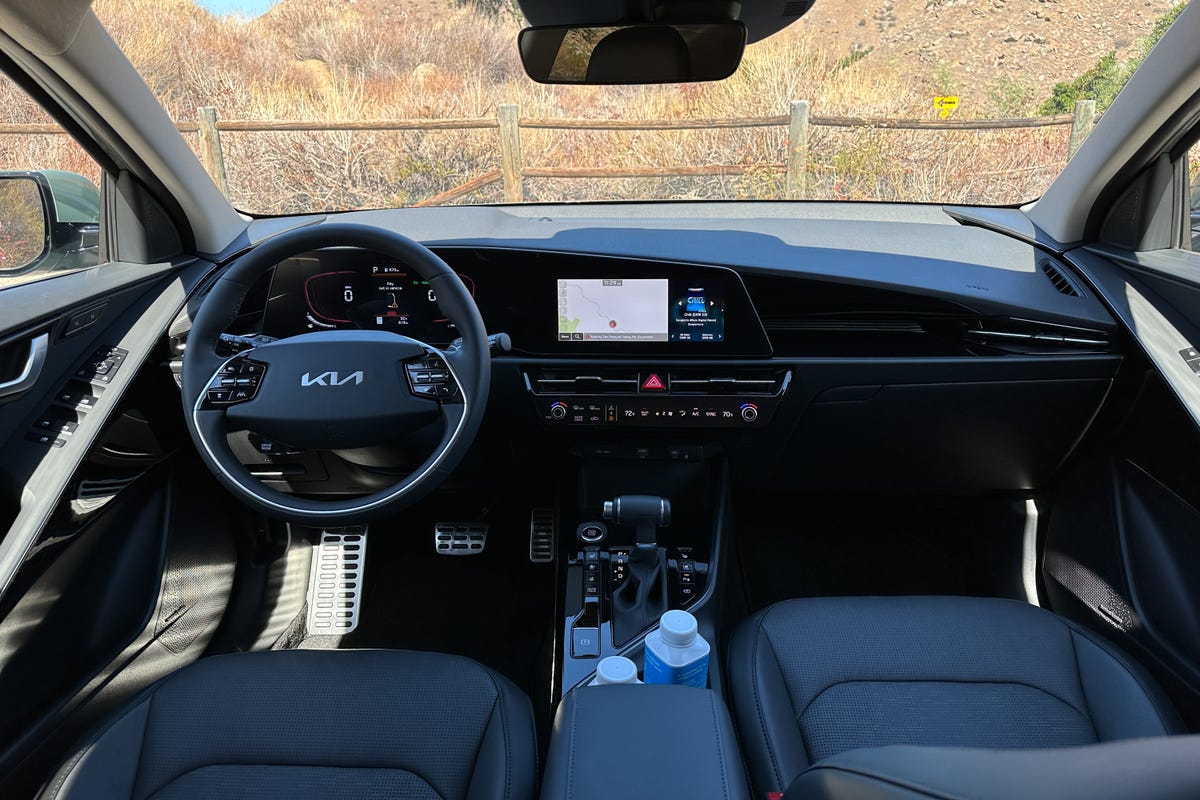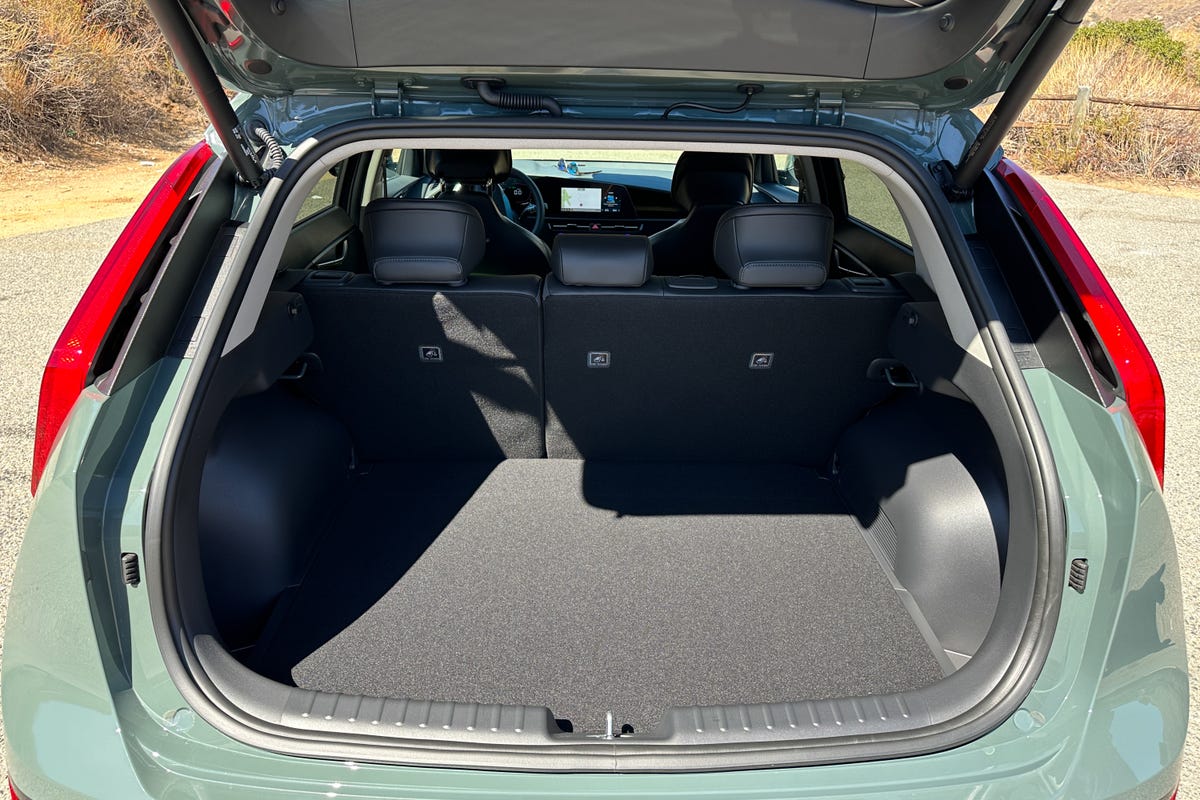With practical packaging, great feature content, super efficient hybrid powertrains and a fully electric option, the Kia Niro crossover is an excellent value. But there’s one thing the Niro always lacked: style. It just looked like a generic hatchback with a similarly bland interior, but that’s all changing with the 2023 Niro, which puts design at the forefront while retaining the old car’s key attributes.
As we’ve come to expect from Kia, the new Niro has its own unique flair that fits in with the rest of the company’s lineup without feeling like a cookie-cutter design. It looks kind of like a cartoon robot whale, if you can imagine such a thing, with a new interpretation of Kia’s tiger nose grille consisting of a thin wing-like black piece at the top and a large, trapezoidal lower intake. The angular headlights feature an LED signature shaped like a heartbeat on a medical monitor, and the boomerang-shaped taillights sit high up on the rear end. Instead of just being found around the wheel arches and lower sections, the new Niro’s body cladding extends across the doors as an integral part of the design; on the base model the cladding is matte black plastic, but it’s gloss black on upper trims.
The most eye-catching part of the 2023 Niro’s design are the side blades that make up the car’s C-pillar. Its shape follows the angle of the taillights and rear window, and there’s an actual air pass-through behind the blade that increases aerodynamics. As standard the side blade is just painted in body color, but if you choose the Niro’s CityScape Green or Mineral Blue paints the blade can be finished in gloss black to match the rest of the Niro’s lower body cladding. I think it looks great, but in other countries the blade is also available in wilder contrasting finishes like bright red or orange.

The taillights and side blade look awesome.
Daniel Golson/CNET
The new Niro’s interior is visually interesting, too, taking lots of styling cues from the EV6. The thin armrests on the door panels rise up to meet the dashboard, which features a large black panel housing two displays and neat ambient lighting in front of the passenger. The Niro shares the same touch panel and pair of knobs as the EV6 that switches from showing climate to audio/navigation controls at the touch of a button. I especially love the two-spoke steering wheel, and the 1990’s alarm clock font for the digital gauge cluster.
Front of mind for Kia’s interior designers was sustainability, and the 2023 Niro has some cool touches. Vegan upholstery is the only option, with upper trims getting a leather alternative that feels premium and has a finish made from eucalyptus leaves. The headliner is made from recycled wallpapers and is much more interesting than a regular cheap cloth one would be, and the door panels use BTX-free paint.
Kia hasn’t changed anything about the Niro hybrid’s powertrain in terms of specs. It pairs a naturally aspirated 1.6-liter 4-cylinder engine with a 6-speed dual-clutch automatic transmission and a single electric motor, resulting in a total of 139 horsepower and 195 pound-feet of torque sent to the front wheels. Hitting 60 mph takes about 10.5 seconds, but the Niro is peppy enough to not feel sluggish, even when merging onto the highway.

Dual screens are standard.
Daniel Golson/CNET
Speed isn’t really the point of the Niro, though. In its most efficient trim the Niro hybrid has EPA fuel economy ratings of 53 mpg combined, 53 mpg city and 54 mpg highway, improvements of 3 mpg in the combined figure and 6 mpg on the highway compared to the old Niro. With its larger 18-inch wheels the loaded SX Touring model I’m driving takes a 4-mpg hit in the combined rating and a whopping 9 fewer mpg on the highway, but even on this hot day with the air conditioning blasting, I average 52 mpg after nearly 100 miles of driving fairly aggressively on mountain roads outside San Diego.
The 2023 Niro’s seats have more supportive cushions and bolstering, and the suspension feels softer and more refined. Thanks in part to its real automatic transmission, the Niro’s hybrid system is a lot more well integrated than in some of its competitors, with smoother engagement of the gas engine and a less coarse overall experience. One major gripe is with the regenerative braking, which has three different intensity settings as well as the ability to turn it off completely. The most aggressive regen setting can’t achieve full one-pedal driving like in an electric car, but it does provide very strong deceleration. The problem is that the deceleration isn’t linear; in the Level 3 setting it’s hard to modulate as the immediate deceleration is too strong even when you lightly lift off the pedal. But while the Level 2 setting doesn’t have the same jerky action, it isn’t nearly as strong as I’d like.

The electric Niro doesn’t look too different.
Daniel Golson/CNET
The fully electric Niro EV visually distinguishes itself with slightly different bumper designs, a silver finish to the body cladding and side blades, and a rotary shifter on the center console. Its powertrain also hasn’t changed much from the previous generation, using a 64.8-kilowatt-hour battery pack and a 201-hp electric motor at the front axle. Kia says the Niro EV takes 7.8 seconds to hit 60 mph, nearly 3 seconds quicker than the Niro hybrid. Its estimated range of 253 miles is about a dozen miles better than last year’s Niro EV, too.
If the Niro hybrid is a good driving experience, the Niro EV is a great one, and not just because it’s quicker. The steering is heavier, there’s less body roll and the ride is better. (The smaller 17-inch wheels on the Niro EV I’m driving certainly help in that regard.) The Niro EV also doesn’t have the same regen issue as the hybrid. It features Kia’s i-Pedal mode that provides full one-pedal driving, which means the Niro EV can come to a complete stop just through the regenerative braking. It’s good enough that I don’t need to hit the brake pedal in about 80% of regular daily driving situations.
Sadly, because the Niro doesn’t use the same 800-volt architecture as Hyundai Motor Group’s EVs based on the E-GMP platform, it isn’t able to use super-fast 350-kW chargers. The Niro EV can only charge at speeds of up to 85 kW, which is enough to go from 10% to 80% charge in less than 45 minutes — not exactly competitive by 2022 standards. Plugging the Niro EV into a Level 2 charger using the 11-kW onboard charger can fully replenish its battery in under 7 hours. Kia’s own EV6 has the Niro EV easily beat in terms of charge times, but the Niro’s longer range (versus the EV6’s standard 232-mile battery pack), more traditional packaging and cheaper price keep it a compelling option.
Kia also offers the 2023 Niro with a plug-in hybrid powertrain that I’m not able to sample. It pairs the same four-cylinder engine with a more powerful motor and an 11.1-kWh battery for totals of 180 hp and 195 lb-ft, and the PHEV has a fully electric range of 33 miles. The battery can be recharged in less than 3 hours on a Level 2 charger.

It’s a practical package.
Daniel Golson/CNET
Despite its major upgrades in terms of styling and quality, the 2023 Niro is only $1,800 more expensive than the outgoing model. The entry-level LX trim starts at $27,785 including a $1,295 destination charge, and for that price you get automatic dual-zone climate control, an 8-inch touchscreen with wireless Apple CarPlay and Android Auto and a 6-speaker sound system. Every Niro also has automatic emergency braking, automatic high beams, blind-spot monitoring, lane-departure warning, lane-keeping assist, rear cross-traffic alert and a rear occupant alert, and available on all but the base LX is adaptive cruise control with stop and go, steering assist and parking sensors.
The EX trim comes in at $30,385 and upgrades both dashboard screens to 10.3-inch units, also bringing heated front seats, a wireless phone charger, paddle shifters, rain-sensing wipers, ambient lighting, a power driver’s seat and air vents for the second row. Jumping to the $33,785 SX adds ventilation to the front seats, a powered liftgate, a heated steering wheel and an eight-speaker Harman Kardon sound system. A Touring package is available for $2,300 on both the EX and SX trims and consists of the 18-inch wheels, aluminum pedals and some other appearance bits. Pricing for the Niro EV hasn’t been announced yet, but it should start at around $42,000. The EV gets features unavailable on other Niros like a head-up display, a power passenger seat and smart park.
No matter which version of the Niro you buy, you’re getting an eye-catching hatchback with a litany of modern features and impressive efficiency. To really put it into perspective, the Niro hybrid starts at $1,615 more than the Toyota Prius, its main competitor, which gets only marginally better fuel economy and is a much less appealing overall package.
Editors’ note: Travel costs related to this story were covered by the manufacturer, which is common in the auto industry. The judgments and opinions of CNET’s staff are our own and we do not accept paid editorial content.
2023 Kia Niro First Drive Review: Style and Substance – CNET
Source: Media Star Philippines


0 Comments